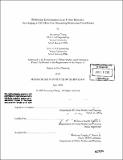| dc.contributor.advisor | Joseph Ferreira, Jr. | en_US |
| dc.contributor.author | Chung, Jee-seong, 1969- | en_US |
| dc.contributor.other | Massachusetts Institute of Technology. Dept. of Urban Studies and Planning. | en_US |
| dc.coverage.spatial | n-us-ma | en_US |
| dc.date.accessioned | 2011-08-18T19:10:13Z | |
| dc.date.available | 2011-08-18T19:10:13Z | |
| dc.date.copyright | 2003 | en_US |
| dc.date.issued | 2003 | en_US |
| dc.identifier.uri | http://hdl.handle.net/1721.1/65261 | |
| dc.description | Thesis (M.C.P.)--Massachusetts Institute of Technology, Dept. of Urban Studies and Planning, 2003. | en_US |
| dc.description | Includes bibliographical references (p. 119-123). | en_US |
| dc.description.abstract | Recently, the pedestrian environment has been recognized as an important factor for sustainable urban development movements such as the New Urbanism (NU) movement and Transit Oriented Development (TOD). Consequently, many pedestrian initiatives have been implemented throughout the US while the necessity for measuring the existing pedestrian environment has increased. Despite the increased attention to the pedestrian environment, little effort has been made to evaluate its performance. Level of Service (LOS) models have been developed and widely used, but these provide insufficient information about the pedestrian environment of an area. In this study, a grid-based GIS model proposed for measuring pedestrian friendliness of an area is developed and applied to the City of Boston. The proposed method uses already existing data to measure performance with respect to the condition of pedestrian facilities and their attractiveness to walkers. Unlike other pedestrian models, it evaluates the performance of street segments by considering not only the characteristics of the immediate vicinity but also those of adjacent road segments within a certain distance. The approach also avoids the problem of defining arbitrary spatial areas and boundaries, which may generate a false sense of precision by arbitrarily dissecting the urban pattern into zones. By distinguishing between ease of pedestrian movement and abundance of desirable destinations, we are able to differentiate between the potential for and reality of pedestrian friendliness. The results for Boston indicate the relevance of quantifying multiple dimensions of pedestrian friendliness. They also highlight the importance of land use context in calibrating meaningful measures of accessibility and level of service. While much sensitivity analysis and model tuning remains to be done, the prototype suggests that these types of models can be useful in shaping local policy decisions and contributing to a better understanding of pedestrian environments in the urban scale. This understanding will aid planners in evaluating, designing, and implementing pedestrian-friendly projects that enhance the sustainability of the urban environment. | en_US |
| dc.description.statementofresponsibility | by Jee-seong Chung. | en_US |
| dc.format.extent | 123 p. | en_US |
| dc.language.iso | eng | en_US |
| dc.publisher | Massachusetts Institute of Technology | en_US |
| dc.rights | M.I.T. theses are protected by
copyright. They may be viewed from this source for any purpose, but
reproduction or distribution in any format is prohibited without written
permission. See provided URL for inquiries about permission. | en_US |
| dc.rights.uri | http://dspace.mit.edu/handle/1721.1/7582 | en_US |
| dc.subject | Urban Studies and Planning. | en_US |
| dc.title | Pedestrian environment as an urban indicator : developing a GIS model for measuring pedestrian friendliness | en_US |
| dc.type | Thesis | en_US |
| dc.description.degree | M.C.P. | en_US |
| dc.contributor.department | Massachusetts Institute of Technology. Department of Urban Studies and Planning | |
| dc.identifier.oclc | 52971392 | en_US |
